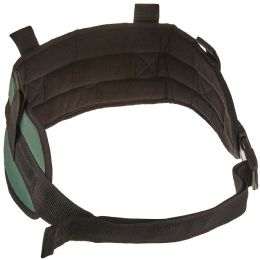


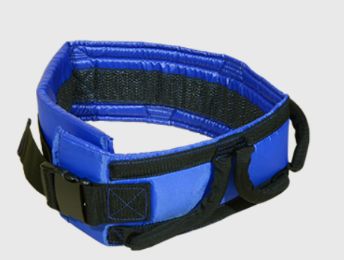

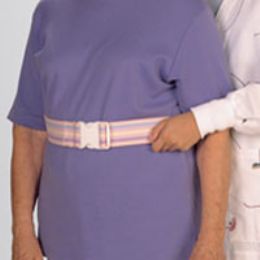
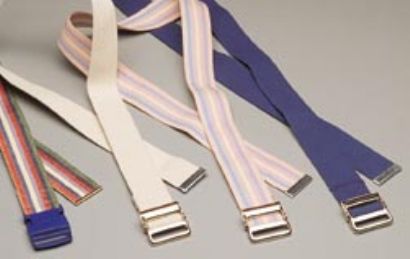

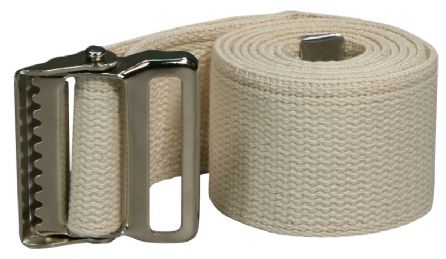



What is a Gait Belt?
A gait belt is a simple medical device that helps a caregiver or a medical staff worker to assist an individual, or patient, to stand up and safely ambulate them from one place to another such as going from a wheelchair and walking over to a sofa, or to help hold up someone during a brief walk if they are too weak or unsteady to walk on their own. Gait belts are usually made of canvas, cotton webbing, leather, or nylon, and have a durable buckle on one end. They usually are between 1 ½ to 4 inches wide, 50 to 60 inches long, and some come with handles for additional holding options for the caregiver.
Why Are Gait Belts Important?
Gait belts are essential tools for ensuring the safety of both patients and caregivers when transferring patients who are cooperative, partially dependent and who have some weight-bearing capacity with their legs. Without a gait belt to transfer or ambulate a patient, the caregiver is forced to grasp onto the patient directly, causing possible discomfort or embarrassment to the patient as well as a potential injury from a slip or fall due to the caregiver not having a good secure grip. While offering a safer way to support a patient, it also can lessen the risk of injuring the caregiver or creating their own back, leg or shoulder pain.
Proper Way to Apply a Gait Belt onto a Patient
A gait belt is put onto the patient to help him or her transfer from a bed to chair, or a wheelchair to car, to help reposition a patient in a chair or car, to support a patient during ambulation or if needed, to help control and guide a patient’s fall. Yet before assisting a patient, there are proper ways to put on the gait belt for the safety of both patient and caregiver.
When putting on a gait belt, keep two fingers between the patient’s body and the belt and tighten the belt until it has just enough room for the caregiver’s fingers. If the belt is too loose it could either slip upward and injure the patient’s chest, especially if the patient is a female, or increase the risk of dropping the patient once he or she stands up and their weight is put on the belt.
Using a gait belt is a two person operation (patient and caregiver) but sometimes due to the weight or general weakness of the patient, more than one caregiver may be needed. When transferring a patient, always transfer to the patient’s strongest side so they can assist as much as possible. Gait belts with handles can offer an easier grip to the caregiver, increasing the control and security of the patient’s movements.
Before lifting the patient, the caregiver should ensure the gait belt is securely fastened and cannot be easily undone by the patient during the transfer, also ask the patient is he or she is comfortable and ready to stand up. With a layer of clothing between the patient and the belt to avoid abrasion, the caregiver must keep the patient as close as possible to himself and place himself in front of the patient to ensure that there is good footing to safely lift and bear the patient’s weight. Position the patient’s feet in between the caregiver’s feet and using good body mechanics of a rocking and pulling motion rather than a jerking and lifting motion, coordinate with the patient in assisting them in standing up when using the gait belt.
Once the patient is standing up with assistance, the caregiver should put one hand to the side of the belt and the other hand at the rear of the belt and once ready, begin assisting the patient in ambulating and transferring safely to a bed, chair, wheelchair, car, or any other acceptable place.
Before transferring, make sure to remove footrests and maybe the arms from a wheelchair, lower bedrails, and keep away other items that may get in the way of the transfer. If the patient begins to fall it is important for the caregiver not to attempt to stop the fall. Instead, with feet wide apart and knees bent, attempt to slow the patient’s fall and lower him to the ground. The key is to slow down and ease their fall, protecting the head and spine as much as possible. Trying to abruptly stop a patient from falling and keeping him upright could cause pain and injury to the caregiver.
Gait belts may not be suitable for heavy or obese people or individuals with recent back or abdominal surgery, abdominal aneurysm, organ replacements, etc. nor should a gait belt ever be used as a physical restraint, and should be avoided with patients who have catheters and/or G-tubes.
Rehabmart is pleased to offer a wide selection of efficacious gait belts from such superior quality vendors as Posey, Bird & Cronin, Inc., Drive Medical, Prism Medical, Patterson Medical, North Coast, Skil-Care, DeRoyal, Medline, and more.
Hulet Smith, OT
Rehabmart Co-Founder & CEO
ws